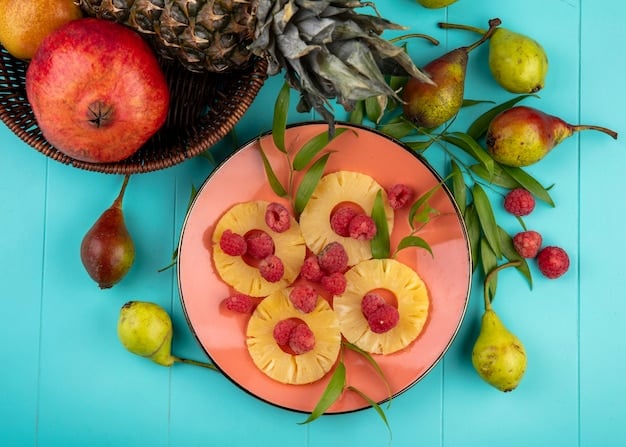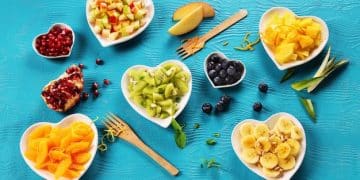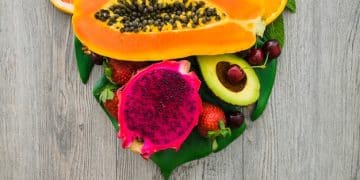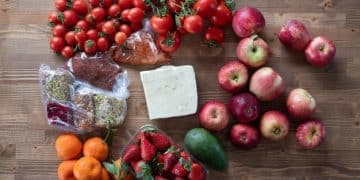Snack Smart: 10 Healthy & Delicious Snacks Under 200 Calories

Navigating the world of healthy eating often highlights the importance of strategic snacking to maintain energy levels and nutritional balance without exceeding calorie goals, a challenge precisely met by focusing on delicious options under 200 calories.
In the bustling rhythm of modern life, finding balance in our daily nutrition often feels like a constant negotiation. We crave convenience, but also nourishment. This is where the art of smart snacking truly shines. Mastering the technique of selecting Snack Smart: 10 Healthy and Delicious Snacks Under 200 Calories can revolutionize your approach to sustained energy and mindful eating.
The art of healthy snacking: more than just calorie counting
Snacking, often villainized in dietary circles, is not inherently detrimental to health or weight management. In fact, when done thoughtfully, it can be a powerful tool for supporting metabolic health, regulating blood sugar, and providing sustained energy between meals. The key lies in understanding what constitutes a “healthy” snack, extending beyond a mere calorie count. It’s about nutrient density, satiety, and the overall impact on your body.
Many people fall into common snacking traps, opting for highly processed, sugar-laden, or fat-dense options that offer little nutritional value and often lead to energy crashes. These choices, while convenient, can derail dietary goals and contribute to feelings of sluggishness. The true art of healthy snacking involves conscious decision-making, selecting foods that fuel rather than deplete.
Understanding nutrient density and satiety
When we talk about nutrient density, we refer to the amount of vitamins, minerals, fiber, and other beneficial compounds a food contains relative to its calorie content. A snack high in nutrient density provides a lot of goodness for a relatively small caloric intake. This is crucial for overall health and for ensuring your body receives the raw materials it needs to function optimally.
- Fiber powerhouse: Foods rich in fiber, like fruits, vegetables, and whole grains, promote digestive health and contribute significantly to satiety, helping you feel full longer.
- Protein punch: Protein is essential for muscle repair and growth, and it’s also highly satiating. Including protein in your snacks can help curb cravings and stabilize blood sugar.
- Healthy fats: While calorie-dense, healthy fats from nuts, seeds, and avocados are vital for hormone production and nutrient absorption. Portion control is key here.
Satiety, the feeling of fullness and satisfaction, is arguably as important as calorie control when it comes to snacking. A snack that leaves you hungry shortly after eating defeats its purpose. Opting for snacks that combine fiber, protein, and healthy fats will maximize satiety, making you less likely to overeat at your next meal or reach for another snack too soon.
The strategic role of snacking in weight management
For those managing their weight, strategic snacking can be a game-changer. Rather than viewing snacks as an indulgence, consider them mini-meals designed to prevent extreme hunger, which often leads to poor food choices. By keeping hunger at bay, you’re better equipped to make mindful decisions at meal times and avoid overeating.
Furthermore, well-timed snacks can help maintain a steady metabolism. Skipping meals or going too long without eating can signal to your body to conserve energy, potentially slowing down your metabolic rate. Small, balanced snacks can keep your metabolism ticking along efficiently, supporting your body’s fat-burning processes.
Ultimately, the art of healthy snacking is a holistic approach, moving beyond simple calorie counting to embrace nutrient density, satiety, and strategic timing for optimal health and well-being. It transforms snacking from a potential pitfall into a powerful ally in your journey towards a healthier lifestyle.
Decoding the 200-calorie threshold: why it matters
The 200-calorie threshold for snacks is not an arbitrary number but a practical guideline rooted in nutritional science and effective weight management strategies. This seemingly small limit offers a crucial balance: it’s enough to provide a genuine energy boost and stave off hunger without contributing excessively to your daily caloric intake. Understanding why this specific threshold matters can empower you to make smarter snacking choices.
From a physiological perspective, snacks within this range are typically digested relatively quickly, providing immediate energy without causing a significant spike in blood sugar followed by a sharp drop, which often leads to renewed hunger. Larger snacks can sometimes mimic a small meal, potentially disrupting mealtime appetite and overall calorie control for the day.
Portion control and mindful eating
One of the primary benefits of adhering to the 200-calorie limit is its implicit enforcement of portion control. In an age of supersized servings, it’s remarkably easy to overestimate appropriate portion sizes, especially when it comes to nutrient-dense but calorie-rich foods like nuts or avocados. By focusing on snacks under 200 calories, you’re naturally encouraged to measure and be mindful of how much you’re consuming.
- Awareness: It forces you to read labels and understand the caloric density of different foods, fostering greater awareness of your dietary habits.
- Prevention of overeating: By setting a clear boundary, it helps prevent mindless snacking that can quickly add up to hundreds of extra calories.
- Mindful consumption: Smaller portions encourage you to slow down, savor your snack, and truly pay attention to your body’s hunger and fullness cues.
This disciplined approach to portion control is a cornerstone of sustainable weight management and overall healthy eating. It shifts the focus from rigid restriction to an informed approach to consumption.
The role in preventing calorie creep
Calorie creep is a subtle yet significant saboteur of dietary goals. It refers to the accumulation of extra calories throughout the day, often from seemingly innocuous sources like extra bites, sips of sugary drinks, or oversized snacks. These small additions, when summed up, can easily lead to a caloric surplus and hinder weight loss or maintenance efforts.
By consciously choosing snacks under 200 calories, you significantly mitigate the risk of calorie creep. For someone aiming for a daily intake of 1800-2000 calories, two 200-calorie snacks per day (400 calories total) represent a manageable and healthy contribution. In contrast, two 400-calorie snacks would account for 800 calories, leaving less room for balanced meals and potentially pushing daily intake beyond healthy limits.
Moreover, opting for lower-calorie snacks allows for greater flexibility in your main meals. You won’t feel the need to drastically cut back on dinner if your snacks have been kept in check. This psychological benefit can lead to a more sustainable and enjoyable eating pattern, reducing feelings of deprivation and increasing adherence to dietary goals.
In essence, the 200-calorie threshold serves as a strategic guardrail, helping you navigate the complexities of daily nutrition with greater precision and control. It’s a pragmatic approach that supports both immediate hunger management and long-term health objectives.
Snack smart: key ingredients for healthier choices
Embarking on a journey to snack smarter requires a foundational understanding of what makes a snack truly beneficial beyond its calorie count. It’s about selecting ingredients that offer maximum nutritional payoff, ensuring your body receives the fuel it needs without unnecessary additives. Focusing on whole, unprocessed foods is a paramount principle in this regard, forming the backbone of any healthy snacking strategy.
The marketplace is flooded with snack options, many disguised as “healthy” but laden with hidden sugars, unhealthy fats, and excessive sodium. Learning to discern genuine nutritional value from marketing claims is a critical skill. By prioritizing certain key ingredients, you can confidently build a repertoire of snacks that genuinely contribute to your well-being.

The power of whole foods
Whole foods are those that are minimally processed and retain their natural nutrients. They are the cornerstone of a healthy diet, and this principle extends to snacking. Opting for whole fruits, vegetables, nuts, seeds, and whole grains provides a broad spectrum of vitamins, minerals, fiber, and antioxidants that are often lost in processed snack equivalents.
- Fruits: Nature’s candy, offering natural sweetness, vitamins, fiber, and antioxidants. Berries, apples, and bananas are excellent choices.
- Vegetables: Low in calories but high in fiber, vitamins, and minerals. Think carrot sticks, cucumber slices, or bell pepper strips.
- Nuts and seeds: Packed with healthy fats, protein, and fiber. Almonds, walnuts, chia seeds, and flax seeds are highly nutritious, but require portion control due to their calorie density.
- Whole grains: Provide complex carbohydrates for sustained energy and fiber. Small portions of oatmeal or whole-grain crackers fit the bill.
By choosing whole foods, you inherently reduce your intake of artificial sweeteners, preservatives, and unhealthy trans fats, all of which can negatively impact health over time. This approach simplifies healthy eating, making it intuitive and effective.
Fiber-rich foods for sustained fullness
Fiber is a magnificent nutrient often overlooked in the quest for healthy eating. It plays a pivotal role in digestive health, but more importantly for snacking, it contributes significantly to satiety. Dietary fiber adds bulk to your food, slowing down digestion and absorption, which helps to stabilize blood sugar levels and keep you feeling full for longer periods.
When selecting snacks, consciously look for those high in fiber. This includes most fruits and vegetables, legumes (like chickpeas), and certain whole grains. A snack high in fiber is less likely to leave you rummaging through the pantry an hour later. It’s the ultimate tool for preventing overeating and managing hunger between meals effectively.
Beyond satiety, fiber also has numerous other health benefits, including reducing cholesterol levels and lowering the risk of chronic diseases. Incorporating plenty of fiber into your snacks is a simple yet powerful way to boost your overall health profile.
Protein for muscle maintenance and satiety
Protein is another critical component of a smart snack. It’s essential for building and repairing tissues, producing enzymes and hormones, and it’s also incredibly satiating. Consuming protein-rich snacks can help maintain muscle mass, especially important for those engaged in regular physical activity or on a weight loss journey.
Protein takes longer to digest than carbohydrates, meaning it keeps you feeling full for a longer duration. This makes protein an excellent choice for snacks designed to bridge the gap between meals. Good protein sources for snacks include Greek yogurt, cottage cheese, hard-boiled eggs, and small portions of lean deli meat.
Combining protein with fiber often creates the most effective and satisfying snack. This synergy ensures both immediate and prolonged satiety, supporting your energy levels and helping you stick to your dietary goals. By strategically incorporating these key ingredients, you elevate your snacking habits from mere calorie consumption to a powerful act of self-nourishment.
10 healthy and delicious snacks under 200 calories
When it comes to smart snacking, variety and deliciousness are just as important as nutritional value and calorie control. To keep your palate engaged and your body fueled without excess, here are 10 exceptional snack ideas, each carefully curated to fall under the 200-calorie mark, offering a blend of flavor, fiber, and vital nutrients.
These options are designed to be both accessible and satisfying, proving that healthy eating can be both easy and enjoyable. They move beyond the mundane, presenting choices that truly elevate your snacking experience while adhering to the essential 200-calorie threshold.
- Apple slices with natural peanut butter (1 medium apple, 1 tbsp PB): approx. 180-190 calories. The fiber from the apple paired with the protein and healthy fats from peanut butter makes for a perfectly balanced and satisfying snack.
- Greek yogurt with berries (1/2 cup plain Greek yogurt, 1/4 cup mixed berries): approx. 120-150 calories. High in protein and probiotics, Greek yogurt promotes gut health, while berries add antioxidants and natural sweetness.
- Hard-boiled eggs (2 large): approx. 140 calories. A powerhouse of protein, eggs are incredibly filling and versatile. They are also packed with essential vitamins and minerals.
- Baby carrots with hummus (1 cup baby carrots, 2 tbsp hummus): approx. 150-170 calories. Crunchy carrots provide fiber, and hummus (made from chickpeas) adds protein and healthy fats.
- Air-popped popcorn (3 cups): approx. 90-100 calories. A whole grain, popcorn is surprisingly low in calories and high in fiber when air-popped and lightly seasoned.
- Edamame (1 cup, shelled): approx. 190 calories. These versatile soybeans are rich in plant-based protein and fiber, making them an excellent choice for sustained energy.
- Cottage cheese with pineapple (1/2 cup 2% cottage cheese, 1/4 cup pineapple chunks): approx. 140-160 calories. Cottage cheese offers slow-digesting protein, and pineapple adds a refreshing, sweet tang with vitamin C.
- Small handful of almonds (1/4 cup or about 23 almonds): approx. 160-170 calories. Almonds are a fantastic source of healthy fats, fiber, and protein, great for a quick energy boost.
- Rice cakes with avocado (1 rice cake, 1/4 small avocado): approx. 170-190 calories. A simple, satisfying snack with healthy monounsaturated fats from avocado and a crisp base from the rice cake.
- Celery sticks with tuna salad (2 large celery stalks, 1/4 cup tuna salad made with Greek yogurt): approx. 160-180 calories. A lean protein source combined with crunchy, low-calorie celery provides both satiety and nutrients.
Each of these options offers an optimal blend of nutrients without exceeding the 200-calorie limit, making them perfect for guilt-free indulgence that supports your health goals. Remember to choose organic options where possible and monitor portion sizes diligently.
Practical tips for incorporating smart snacks into your routine
The journey to embracing smart snacking goes beyond merely knowing what to eat; it involves strategically integrating these choices into your daily life. Developing practical habits and employing thoughtful planning can make a significant difference in how effectively you maintain a healthy eating pattern. Without a systematic approach, even the best intentions can falter in the face of busy schedules and spontaneous hunger pangs.
Successful snacking is about preparation, awareness, and flexibility. It’s about empowering yourself to make the healthy choice the easy choice, even when life gets hectic. By implementing a few straightforward strategies, you can transform your snacking habits from a potential source of dietary stress into a consistent cornerstone of your well-being.
Meal prepping your snacks
One of the most effective ways to ensure healthy snacking is through meal prepping. Just as you might prepare your main meals for the week, dedicating time to prepare your snacks can save you from reaching for less healthy, processed options when hunger strikes unexpectedly. This proactive approach ensures that nutritious choices are always within arm’s reach.
- Portion out: Divide nuts, seeds, or pre-cut veggies into single-serving containers or bags. This automatically enforces portion control.
- Wash and cut: Have fruits and vegetables like apples, carrots, and bell peppers washed and pre-cut, making them grab-and-go friendly.
- Assemble components: For snacks like Greek yogurt with berries or tuna salad, have the individual components ready to quickly assemble before heading out or mid-day.
The beauty of snack prepping is its ability to eliminate decision fatigue. When you’re hungry, your willpower is often at its lowest. Having a pre-made healthy snack ready to consume removes the need to think, making the healthy option the path of least resistance.
Listening to your body’s hunger cues
While planning is crucial, equally important is developing an intuitive understanding of your body’s hunger cues. Snacking should be a response to true physical hunger, not boredom, stress, or habit. Learning to differentiate between these signals is a powerful step towards mindful eating.

Before reaching for a snack, take a moment to assess your hunger level. Are you truly hungry, or are you just feeling restless? Sometimes, a glass of water or a brief walk can address what feels like hunger. When you do eat, practice mindful eating: savor each bite, notice the textures and flavors, and pay attention to when you start to feel satisfied.
This practice helps prevent overeating and ensures that your snacks are consumed purposefully, as fuel, rather than as a distraction or emotional comfort. It fosters a healthier relationship with food, where eating is a deliberate act of nourishment.
Flexibility and adaptability
Life doesn’t always go according to plan, and your snacking strategy should be flexible enough to adapt. While meal prepping is ideal, there will be times when you’re caught unprepared. In these moments, knowing a few healthy, readily available options can be a lifesaver.
Keep a mental list of emergency healthy snacks you can grab at a supermarket or convenience store. Think of things like single-serving plain Greek yogurt, a piece of fruit, or a small bag of unsalted nuts. The goal is to avoid falling back on highly processed options simply because they are convenient.
Also, don’t be afraid to adjust your snack choices based on your activity level or immediate needs. If you’ve just completed an intense workout, a slightly more calorie-dense or protein-rich snack might be more appropriate. The key is balance and responsiveness to your body’s current demands, ensuring your smart snacking continuously supports your overall health and wellness goals.
Avoiding common snacking pitfalls and staying on track
Even with the best intentions and a roster of healthy snack ideas, navigating the world of daily eating can present various challenges. Common snacking pitfalls often involve mindless eating, succumbing to emotional triggers, or being unprepared. Staying on track requires vigilance, self-awareness, and a strategic approach to overcome these obstacles. It’s not just about choosing the right foods but establishing the right habits and environment.
The pursuit of healthy eating is a continuous learning process. Understanding the traps that lead to unhealthy snacking can empower you to anticipate and circumvent them. By addressing the root causes of poor snacking decisions, you build a more robust and sustainable framework for your dietary habits.
Mindless eating and distraction
One of the most pervasive snacking pitfalls is mindless eating. This occurs when you consume food without full awareness or attention, often while distracted by television, a computer, or even just a busy train of thought. Mindless eating frequently leads to overconsumption because your brain doesn’t register the act of eating, nor the signals of satiety.
To combat mindless snacking:
- Eat intentionally: Designate a specific time and place for snacking. Sit down, put away distractions, and focus solely on your food.
- Portion first: Instead of eating directly from a large bag or container, portion out your snack onto a small plate or bowl. This creates a visual cue of how much you’re consuming.
- Slow down: Chew your food thoroughly and take pauses between bites. This allows your brain time to catch up with your stomach’s fullness signals.
Practicing mindful eating turns snacking from a passive act into an active one, promoting greater satisfaction with smaller portions and preventing caloric excess.
Emotional triggers and stress eating
Many people turn to food, especially comfort snacks, in response to emotions rather than physical hunger. Stress, boredom, sadness, or even happiness can act as triggers for emotional eating. These snacks often provide temporary comfort but do not address the underlying emotional need, leading to a cycle of guilt and dissatisfaction.
Identifying your personal emotional triggers is the first step. Once you recognize them, you can develop alternative coping mechanisms:
- Journaling: Write down your feelings to understand what’s truly bothering you.
- Alternative activities: Engage in non-food related activities such as going for a walk, calling a friend, listening to music, or practicing deep breathing exercises.
- Pre-plan: If you know certain situations trigger emotional eating, have a pre-planned, healthy distraction ready.
Seeking professional help from a therapist or counselor can also be beneficial if emotional eating significantly impacts your well-being.
Lack of preparation and accessibility
A common reason for unhealthy snack choices is simply a lack of convenient healthy options. When hunger strikes, and there’s nothing suitable readily available, the temptation to grab the quickest, often unhealthiest, option becomes overwhelming. This pitfall highlights the importance of consistent preparation.
Ensuring accessibility involves:
- Stocking your pantry: Keep a well-stocked supply of healthy, shelf-stable snacks like nuts, seeds, whole-grain crackers, and dried fruit (in moderation).
- Refrigerator readiness: Have fresh fruits and pre-cut vegetables ready to eat.
- “Snack bags” on the go: Carry a small portion of nuts, a piece of fruit, or a hard-boiled egg with you when you leave the house.
By making healthy choices the easiest and most accessible options, you significantly reduce the likelihood of succumbing to unhealthy cravings. Overcoming these common pitfalls requires a combination of foresight, self-awareness, and a commitment to nurturing healthier habits. It’s truly about building an environment that supports your health goals, making smart snacking a natural and effortless part of your daily routine.
| Key Point | Brief Description |
|---|---|
| 🍏 Nutrient Density | Focus on foods rich in vitamins, minerals, and fiber for max value per calorie. |
| ⚖️ 200-Calorie Limit | A crucial guideline for portion control, stopping calorie creep without leaving you hungry. |
| 💡 Smart Choices | Opt for whole foods, fiber, and protein to ensure satiety and nourish your body. |
| 🗓️ Prep & Plan | Meal prepping snacks and listening to hunger cues prevent impulsive unhealthy choices. |
Frequently asked questions about smart snacking
The 200-calorie limit is crucial for portion control and preventing calorie creep. It provides enough energy to curb hunger between meals without adding excessive calories to your daily intake, supporting weight management and consistent energy levels.
Absolutely. The key is to choose nutrient-dense snacks rich in fiber, protein, and healthy fats. These components promote satiety, helping you feel fuller for longer even with a lower calorie count. Examples include Greek yogurt, apples with peanut butter, or hard-boiled eggs.
The frequency of snacking varies based on individual needs and activity levels. Generally, one to two intentional snacks between main meals can help manage hunger and maintain stable blood sugar, preventing overeating at mealtimes. Listen to your body’s true hunger cues.
Common pitfalls include mindless eating (eating while distracted), emotional eating (snacking due to stress or boredom), and poor preparation. Overcoming these requires mindful consumption, finding non-food coping mechanisms for emotions, and always having healthy snack options readily available.
While these snack ideas are generally healthy, individual dietary needs, allergies, and preferences vary. It’s always advisable to consult with a healthcare professional or registered dietitian to tailor snack choices to your specific health requirements and goals.
Conclusion
Embracing the philosophy of “Snack Smart” is a transformative step towards holistic well-being, moving beyond restrictive dieting to a more intuitive and nourishing approach to food. By focusing on delicious, healthy options under 200 calories, we unlock the power of strategic snacking, ensuring sustained energy, optimal nutrient intake, and mindful eating habits. This journey is not just about counting calories, but about cultivating a deeper understanding of our bodies’ needs, fostering a balanced relationship with food, and ultimately, empowering ourselves to make choices that truly support a vibrant, healthier life.





